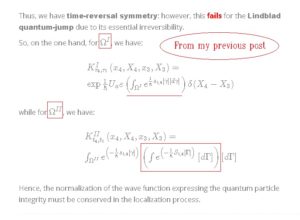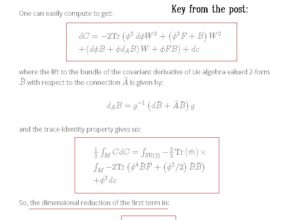This post is on the String-String Duality. In particular, the D=6 string-string duality, which is crucial since it allows interchanging the roles of 4-D spacetime and string-world-sheet loop expansion, and this is mathematically essential for phenomenologically adequate string-compactifications. Here I will prove an equivalence between K3 membrane action and ![]() orbifold action and show how it entails D=6 string-string duality. Working in the bosonic sector, the membrane action is:
orbifold action and show how it entails D=6 string-string duality. Working in the bosonic sector, the membrane action is:
![Rendered by QuickLaTeX.com \[\begin{array}{l}S = {S_M} + \int_{\partial {M^3}} {\left\{ {\frac{1}{2}} \right.} \left( {{g_{mn}}{\eta ^{ij}} + {b_{mn}}{\varepsilon ^{ij}}} \right)\\{{\not \partial }_i}{x^m}{{\not \partial }_j}{x^n} + \frac{1}{2}\left( {{g_{IJ}}{\eta ^{ij}} + {b_{IJ}}{\varepsilon ^{ij}}} \right)\\{{\not \partial }_i}{x^I}{{\not \partial }_j}{x^J} + {\varepsilon ^{ij}}{{\not \partial }_i}{x^J}{{\not \partial }_j}{x^m}\left. {A_m^J(x)} \right\}\end{array}\]](https://www.georgeshiber.com/wp-content/ql-cache/quicklatex.com-e4bf341c4e13e12de614058641cbc716_l3.png)
where:
![]()
Recall I derived, via Clifford algebraic symmetry, the total action:
![Rendered by QuickLaTeX.com \[\begin{array}{l}{S^{Total}} = \frac{1}{{2\pi {\alpha ^\dagger }12}}\int\limits_{{\rm{world - volumes}}} {{d^{26}}} x\,d\,\Omega {\left( {{\phi _{INST}}} \right)^2}\sqrt {\frac{{ - {g_{\mu \nu }}}}{{ - \gamma }}} \,{e^{ - {c_{2n}}/{\Upsilon _\kappa }(\cos \varphi )}} \cdot \\\left( {{R_{icci}} - 4{{\left( {{{\not D}^{SuSy}}\left( {{\phi _{INST}}} \right)} \right)}^2}} \right) + \frac{1}{{12}}H_{3,\mu \nu \lambda }^bH_3^{b,\mu \nu \lambda }/A_\mu ^H + \sum\limits_{D - p - branes} {S_{Dp}^{WV}} \end{array}\]](https://www.georgeshiber.com/wp-content/ql-cache/quicklatex.com-ee1ece1964f54af749ce713bc472b175_l3.png)
which is deep since Clifford algebras are a quantization of exterior algebras, and applying to the ‘Einstein-Minkowski’ tangent bundle, we get via Gaussian matrix elimination, an expansion of ![]() via Green-functions, that yields M-Theory’s action:
via Green-functions, that yields M-Theory’s action:
![Rendered by QuickLaTeX.com \[{S_M} = \frac{1}{{{k^9}}}\int\limits_{{\rm{world - volumes}}} {{d^{11}}} \sqrt {\frac{{ - {g_{\mu \nu }}}}{{ - \gamma }}} {T_p}^{10}{\mkern 1mu} d{\mkern 1mu} \Omega {\left( {{\phi _{INST}}} \right)^{26}}\left( {{R_{icci}} - A_\mu ^H\frac{1}{{48}}G_4^2} \right) + \sum\limits_{Dp} {\not D_\mu ^{SuSy}} {e^{ - H_3^b}}/S_{Dp}^{WV} + \sum\limits_{Dp} {\not D_\nu ^{SuSy}} {e^{H_3^b}}/S_{Dp}^{SV}\]](https://www.georgeshiber.com/wp-content/ql-cache/quicklatex.com-fad4e32f2dd760c5240235fd46ceb3d9_l3.png)
with ![]() the kappa symmetry term. With
the kappa symmetry term. With ![]() the metric on
the metric on ![]() , and
, and ![]() the corresponding coordinates with
the corresponding coordinates with ![]() an antisymmetric 3-tensor. The worldvolume
an antisymmetric 3-tensor. The worldvolume ![]() is:
is:
![]()
The bosonic sector lives on the boundary of the open membrane: two copies of ![]() , which naturally couple to the U(1) connections
, which naturally couple to the U(1) connections ![]() .
.
Now, double dimensional reduction of the twisted supermembrane on:
![]()
of:
![Rendered by QuickLaTeX.com \[\begin{array}{l}S = {S_M} + \int_{\partial {M^3}} {\left\{ {\frac{1}{2}} \right.} \left( {{g_{mn}}{\eta ^{ij}} + {b_{mn}}{\varepsilon ^{ij}}} \right)\\{{\not \partial }_i}{x^m}{{\not \partial }_j}{x^n} + \frac{1}{2}\left( {{g_{IJ}}{\eta ^{ij}} + {b_{IJ}}{\varepsilon ^{ij}}} \right)\\{{\not \partial }_i}{x^I}{{\not \partial }_j}{x^J} + {\varepsilon ^{ij}}{{\not \partial }_i}{x^J}{{\not \partial }_j}{x^m}\left. {A_m^J(x)} \right\}\end{array}\]](https://www.georgeshiber.com/wp-content/ql-cache/quicklatex.com-e4bf341c4e13e12de614058641cbc716_l3.png)
entails that the bosonic sector is that of the heterotic string:
![Rendered by QuickLaTeX.com \[\begin{array}{l}{S_h}\int {{d^2}} \sigma \left\{ {\frac{1}{2}} \right.\left( {{g_{mn}}{\eta ^{ij}} + {b_{mn}}{\varepsilon ^{ij}}} \right){{\not \partial }_i}{x^m}{{\not \partial }_j}{x^n}\\ + \frac{1}{2}\left( {{g_{IJ}}{\eta ^{ij}} + {b_{IJ}}{\varepsilon ^{ij}}} \right){{\not \partial }_i}{x^I}{{\not \partial }_j}{x^I} + \\{\varepsilon ^{ij}}{{\not \partial }_i}{x^I}{{\not \partial }_n}{x^m}\left. {A_m^{(I)}(x)} \right\}\end{array}\]](https://www.georgeshiber.com/wp-content/ql-cache/quicklatex.com-069fca1b3a3394a9397eca8edee98cf7_l3.png)
with gauge group indices I = 1, …, 16.
It gets interesting when we consider:
![]()
with dimension:
![]()
since the worldsheet action:
![]()
is now just a sum of three terms:
![]()
![]()
![]()
and the index I = 1, …, 22 labels 22 gauge fields: 16 coming from the internal dimensions of the heterotic string, and the other 6 gauge fields are the KK modes of the metric and antisymmetric tensor. The action ![]() has a massless spectrum given by moduli fields corresponding to deformations of the Narain lattice and thus take values in the group manifold:
has a massless spectrum given by moduli fields corresponding to deformations of the Narain lattice and thus take values in the group manifold:
![]()
Now, something fundamentally deep has occurred: all the gauge fields of the action  have appeared within a two-dimensional theory, and not a three-dimensional theory
have appeared within a two-dimensional theory, and not a three-dimensional theory
This is precisely the long wavelength limit behavior of the open membrane:
the gauge fields are defined in terms of fields which live on 10-dimensional boundaries of M-theory
In the closed membrane case:
the gauge fields are defined in terms of 11-dimensional fields
Hence, the gauge fields of the closed membrane to be defined over M3 and not over its boundary, unlike the closed membrane, whose action on ![]() is:
is:
![]()
where ![]() is
is ![]() with the spacetime being
with the spacetime being ![]() .
.
Hence, the closed membrane action ![]() on
on ![]() reduces to:
reduces to:
![]()
with:
![]()
![]()
and
![]()
and since ![]() surfaces have no one-cycles, it follows that the three-form potential that appears in
surfaces have no one-cycles, it follows that the three-form potential that appears in ![]() of the action:
of the action:
![]()
can be expanded in terms of the cocycles of ![]() .
.
For the 22 2-cocycles of ![]() , one can decompose
, one can decompose ![]() in a similar way for the two-form potential:
in a similar way for the two-form potential:
![]()
with I = 1, …, 22 labeling the two-cycles of ![]() . So after insertion into
. So after insertion into ![]() , we can derive:
, we can derive:
![]()
Applying reparametrization invariance, one can set:
![]()
where ![]() is a worldvolume coordinate, and now one performs a dimensional reduction of:
is a worldvolume coordinate, and now one performs a dimensional reduction of:
![]()
Here are the key propositions relevant to the membrane/string duality of the low energy theory in D=7.
- the kinetic terms for the gauge fields in D=7 supergravity are:
![]()
derived by a split of the 4-4 field strength ![]() , of the 11-dimensional supergravity action:
, of the 11-dimensional supergravity action:
![]()
from the the following term:
![]()
- Membrane/string duality in D=7 requires the existence of a point in the moduli space of
 where all the 22 gauge fields are enhanced via U(1) gauging: this is key to preserving kappa symmetry. Thus, at the point in the moduli space when the 22 two-cycles vanish the following holds:
where all the 22 gauge fields are enhanced via U(1) gauging: this is key to preserving kappa symmetry. Thus, at the point in the moduli space when the 22 two-cycles vanish the following holds:
![]()
- Hence, dimensional reduction yields:
![]()
So, the S-duality map:
![]()
takes:
![]()
to:
![]()
and is equivalent to the term ![]() in:
in:
![]()
So, the above map acts on the induced metric on the worldvolume: it follows then that the term in ![]() in:
in:
![]()
yields, after a double dimensional reduction, of ![]() , the following:
, the following:
![]()
with:
![]()
which yields an equivalence between:
![]()
and
![]()
Thus, the S-duality map that takes ![]() to
to ![]() also takes
also takes ![]() to dimensionally reduced
to dimensionally reduced ![]() .
.
To achieve the matching of gauge sectors of the closed and open membrane, we must generate the gauge fields of the closed membrane before dimensionally reducing the theory, as opposed to the gauge fields of the open membrane, which are always generated within the two-dimensional theory. This explains the origin of strong-weak duality in string theory. The strong coupling limit of type IIA string is 11-dimensional supergravity which is believed to arise as the long wavelength limit of supermembrane theory. So, gauge fields present in the 3-dimensional theory will be strongly interacting, and will continue to be strongly interacting after dimensional reduction to a two-dimensional theory. However, the open membrane has its gauge fields appearing in two dimensional theories, which are therefore weakly interacting.
So, we must consider the spacetime part of the action for the closed membrane:
![]()
The term:
![]()
can be dimensionally reduced to:
![]()
which is equivalent to the first term in:
![]()
and the term:
![]()
maps to:
![]()
with ![]() and
and ![]() members of
members of ![]()
Now, since the term is topological, and S-duality of the seven dimensional space entails:
![]()
then one can reduce:
![]()
to:
![]()
with ![]() the Hodge dual and in turn, allows us to further reduce to:
the Hodge dual and in turn, allows us to further reduce to:
![]()



